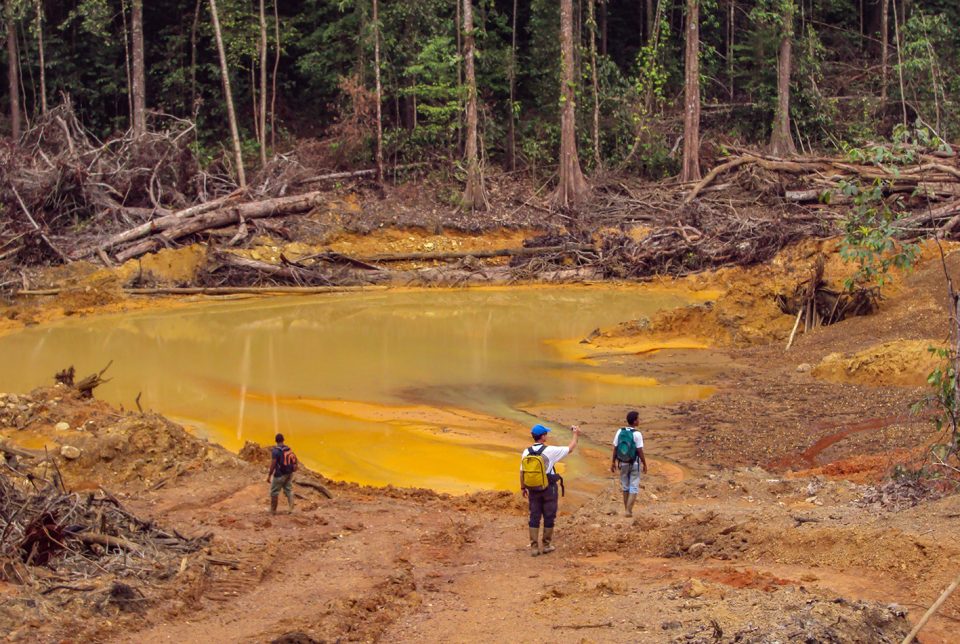Greenstone belts are zones of metamorphic and volcanic rocks that occur within ancient (Archean) formations dominated by granite and gneiss. They are common to most of the cratons in the world and are often associated with world-class gold deposits. The most important greenstone belt in the Pan Amazon is Barama-Mazaruni supergroup, which occurs as a non-contiguous band of rocks in Eastern Venezuela and Guyana, then reappears in Suriname and French Guiana and then further south in Amapá. Altogether, this geological formation covers about 13 million hectares (32 million acres).


Venezuela
Apparently, the richest portion of this geological province is in the Venezuelan state of Bolivar where small-scale placer mining began in the 1930s. The spike in gold prices in 1980 motivated thousands of adventurers to migrate into the region to work the surface (saprolite) gold deposits using hydraulic mining techniques. Most settled near two frontier towns: El Callão in the North and Las Claritas in the South.
The wildcat miners shared these landscapes with three state-owned concessions that were created in the 1970s to exploit the richest and largest deposits. The rights to develop these resources were auctioned in the 1990s to foreign companies, who developed plans to install large-scale open-pit mines. The mines were renationalized in 2008 by the government of Hugo Chavez and the companies, all domiciled in Canada, sued Venezuela for compensation in international courts.
The administration of Nicolas Maduro has delegated the administration of the gold fields to the army, which controls dozens of joint ventures between the state-owned mining corporation (CVG Minerven) and private companies owned by politically influential individuals. There are no large-scale open-pit operations and concessions are exploited using a combination of strip and underground mining technology. Large mines use cyanide and tank-leaching technology to concentrate the gold, while small miners use placer technology and mercury. The gold fields in Venezuela are characterized by thousands of poorly engineered tailings ponds.
In 2017 and 2018, the government reported production from all sources at 8.4 tons and 10.5 tons, respectively. However, an entity that tracks the international trade in gold bullion places that value at 23 and 26 tons. Analysts associated with civil society groups estimate that Venezuelan miners produce about eighty tons per year, which would have a nominal value of ~US$ 42 billion. The vast majority of gold leaves the country via clandestine routes, but it is not clear how much is exported by individuals and criminal gangs avoiding taxes and how much is due to the government seeking to avoid international sanctions.

Guyana
Artisanal gold miners have long dominated gold mining in Guyana, and, unlike other Amazonian countries, most operate as formal companies with legal concessions registered with the government.
Nonetheless, thousands of small-scale miners work under informal agreements for the legally constituted mid-sized companies. Some middle-sized companies allegedly abuse these informal arrangements and expel their subcontractors if they discover a significant gold resource. Despite the evident imperfections in the sector, the government has made a commitment to improve management via its concessionaires and to eliminate the use of mercury by 2025. The goal is to create a niche within the international market for jewelry and bullion that can be certified as sustainable.
The first large-scale corporate investment in Guyana was the Omai open-pit mine, which operated between 1993 and 2005, despite a major disaster in 1997 caused by the failure of its tailings storage facility. The mine was shut when low gold prices made operations unprofitable (~US$500/oz), and may be reopened to exploit what are, apparently, still large gold reserves. The rebirth of Omai is indicative of government policy to facilitate investment by foreign corporations. As of 2022, there were two industrial mines operating, one under construction and four in different stages of development.
Total gold production in Guyana in 2020 was twenty tons per year (~US$1 billion) with about 65 per cent produced by the approximately 15,000 individuals who labor for domestic companies. If all the industrial mines under development come to fruition, the country will produce in excess of forty tons of gold per year.
Suriname and French Guiana
Suriname has a gold mining sector not unlike Guyana. There are approximately 20,000 small-scale miners who produce about half the gold that is exported each year. Rather than a legalized system administered by the government, however, the gold fields are controlled by individuals of the Maroon community who subcontract undocumented Brazilian garimpeiros to exploit surface gold deposits. As in Guyana, investment in corporate mines has increased over the last decade; there are two active open-pit mines in operation and several more under development.
French Guiana shares the tradition of Maroon communities that dominate the small-scale mining sector, which likewise entails the participation of thousands of garimpeiros. The stable legal environment has attracted several corporate investors including both multinational giants and a French company seeking to open an industrial mine in a concession that once housed a placer mine.


